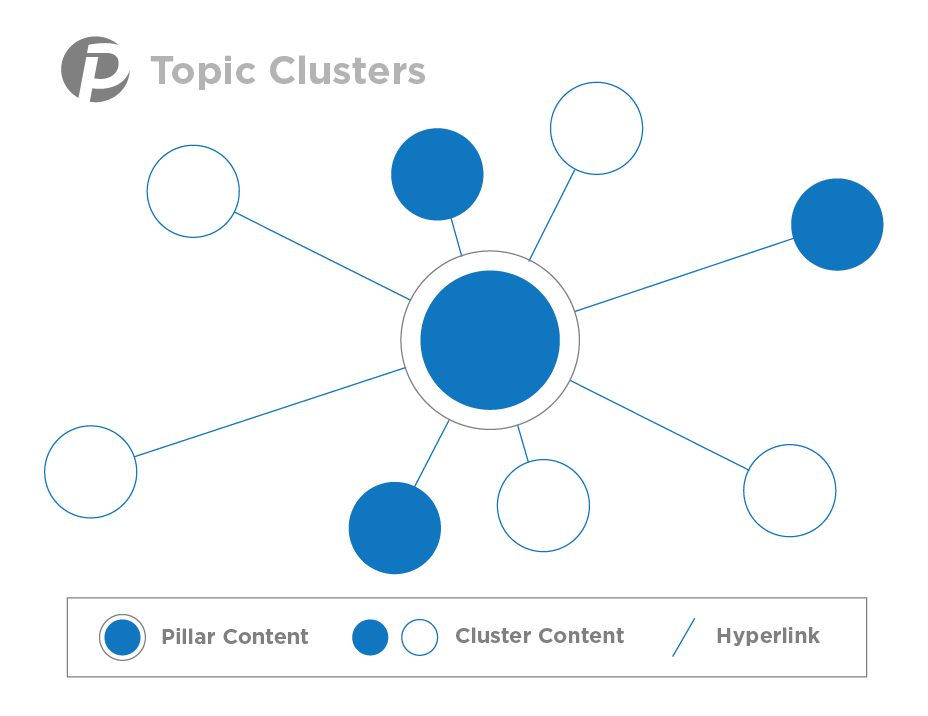5 Simple Steps To Develop A Topic Cluster Content Strategy
When trying to win the top spots on the Google battlefield, it’s critical to have an organized approach to content development. An outline that develops pillar content with topic clusters will support and drive your SEO efforts forward. Utilizing a topic cluster SEO strategy emphasizes the topic instead of a specific keyword, allowing for greater reach and consistent results.
Pillar Content
Pillar content is not focused on selling but rather being an authentic resource, giving a complete high-level overview. This content should be broad and leave plenty of opportunities to get more in-depth in the topic cluster subpages. This way, your pillar content pages can funnel the user along regardless of where they are in the buyer’s journey.
Cluster Content
Topic cluster pages are subpages to the pillar content. The content on your subpages highly focuses on one aspect of the pillar topic. The subpages will fight for more specific keywords or long-tail keywords. While your subpages don’t have to be incredibly long to be effective, you will still want to give them at least 600-700 words so they can rank high in the Search Engine Results Pages (SERPs).
 If you’ve been playing the SEO game for a while, you know what a challenge it can be to find the proper keyword density. Google has done its part to make the algorithm devalue people who are “keyword stuffing” or unnaturally including targeted keywords into the content. Having topic clusters to support your pillar content is a model that visually looks like, well, COVID… Sorry, maybe it’s the year and a half of looking at the zoomed-in view of Coronavirus on pretty much every news outlet, but that’s what came to mind! Stupid COVID invading my creative space. Anyway, your pillar content is the page that covers the base topic at hand. Your pillar content page can link out to subpages that go more in-depth on related subtopics. Including a pillar content page helps your website incorporate a wider net of content development that links back to the pillar content. Having these topic clusters gives a more significant opportunity to have more pages rank in a natural and educational manner.
If you’ve been playing the SEO game for a while, you know what a challenge it can be to find the proper keyword density. Google has done its part to make the algorithm devalue people who are “keyword stuffing” or unnaturally including targeted keywords into the content. Having topic clusters to support your pillar content is a model that visually looks like, well, COVID… Sorry, maybe it’s the year and a half of looking at the zoomed-in view of Coronavirus on pretty much every news outlet, but that’s what came to mind! Stupid COVID invading my creative space. Anyway, your pillar content is the page that covers the base topic at hand. Your pillar content page can link out to subpages that go more in-depth on related subtopics. Including a pillar content page helps your website incorporate a wider net of content development that links back to the pillar content. Having these topic clusters gives a more significant opportunity to have more pages rank in a natural and educational manner.
Here are five simple steps you can take to develop your topic cluster content strategy:
- Identify all the keywords/topics that are most valuable to your company.
- Organize them by value
- Group related topics
- Identify pillar topics that provide a high-level overview
- Identify supporting cluster topics that go into more details and examples to support the pillar topics
Now that you have outlined your pillar topics and topic clusters, you’re ready to develop your content. Topic clusters alone are a powerful SEO tool, but they do their best when paired with quality content that attracts and educates readers. If you need help shaping and developing your topic cluster content, partnering with a marketing agency who knows your business and industry would be a great place to start. Happy writing!
